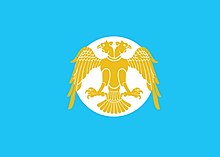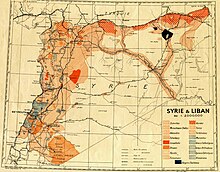This is an old revision of this page, as edited by Khirurg (talk | contribs) at 21:55, 26 November 2015 (Undid revision 692525340 by 81.213.112.217 (talk)). The present address (URL) is a permanent link to this revision, which may differ significantly from the current revision.
Revision as of 21:55, 26 November 2015 by Khirurg (talk | contribs) (Undid revision 692525340 by 81.213.112.217 (talk))(diff) ← Previous revision | Latest revision (diff) | Newer revision → (diff) Ethnic group Official Flag of Syrian Turkmen people Official Flag of Syrian Turkmen peopleOfficially stated by the Syrian Turkmen Assembly, official governing body of the Syrian Turkmen on 25th of November | |
| Regions with significant populations | |
|---|---|
| Aleppo · Damascus · Jazira · Hama · Homs · Latakia | |
| Languages | |
| Turkish · Arabic · Azerbaijani | |
| Religion | |
| Predominately Sunni Islam | |
| Related ethnic groups | |
| Oghuz Turks (Turks · Azerbaijanis · Iraqi Turkmens · Egyptian Turkmens) |
Syrian Turkmen (also referred to as Turks in Syria, Syrian Turkoman or Syrian Turks) (Template:Lang-tr) are Syrian citizens of Turkic heritage and identity. They and their ancestors have lived in present-day Syria since Seljuk times in the 11th century.
During the Syrian Civil War, the Turkmen population of Syria were involved in military actions against Syrian government forces and looked to Turkey for support and protection. More recently, they united under one official governing body, the Syrian Turkmen Assembly and created the military wing of the assembly, the Syrian Turkmen Brigades, to protect Turkmen regions and population and prevent demographic changes in them.
History
Main articles: Zengid dynasty and Ottoman Syria
 Other flags used by Syrian Turkmen and Syrian Turkmen Brigades on battlefield and various places.
Other flags used by Syrian Turkmen and Syrian Turkmen Brigades on battlefield and various places.
In the late 11th century, Syria was first conquered by the Seljuk Turks. After Seljuk Empire was separated into four parts, Malikshah's brother, Tutush, established the Syrian Seljuk State in 1079. Syria was ruled by the Seljuks of Syria till 1117, following which Artuqids, Zengids, Ayyubids and Mamluk Sultanate governed the region. Syria was conquered in 1516 by the Ottoman Sultan Selim I, who defeated the Mamlukes at the Battle of Marj Dabiq near Aleppo in northern Syria. According to the population records of Ottoman Empire in 1518, the total population of Aleppo province was 54,276, of whom 36,217 belonged to the Turkmen population.
Turkmen Settlements and Regions
Turkmen came to Syria in several migration waves. Sometimes the Seljuks and the Mamelukes living in the area adopted the Turkmen in their armies, and some Turkmen became aristocrats. Linda Cichlr wrote about these Turkmen aristocratic families in her book about the city of Damascus.
There are several cities and villages in Syria with significant Turkmen communities. The Turkish Encyclopedia claims there are 523 Turkmen villages in Syria. The main areas of Turkmen concentration are the regions straddling the Turkish border, particularly in the Aleppo and Latakia Governorates. The cities of Aleppo, Manbij, al-Bab, Jarabulus, Azaz, Qatma all have significant Turkmen populations, largely descendants of the Barak tribes, which also dominate the Turkish areas of Killis, Antep and Urfa. In the Latakia Governorate, the border regions of Ras al-Bassit and Bayir (Baer) are predominantly populated by Turkmens.
In the vicinity of Hama and Homs, there are a number of villages which have a majority Turkmen population, including Houla, Aqrab and Talaf.
Population

No official statistics exist on the number of Turkmen in Syria: the country's population census does not ask about ethnic origin, or language, or religion. Bleaney cites several estimates: 1964 - 30,000 Turkomans plus an unknown number of Turks; 1965 - 60,000 Turkomans; 1988 - 88,000 Turkomans, with this last indicating they comprise 1.2% of the Syrian population and are "one of the smallest minority groups in the country". Several sources put them at around 100,000 to 200,000. Some Syrian Turkmen on the other hand have claimed to number between 750,000 and 1,500,000, while the Turkmen National Council announced 3.5 million as the number of Turkmen in Syria.
Notable people
See also
- Syrian Turkmen Assembly
- Syrian Turkmen Brigades
- Syrian Democratic Turkmen Movement
- Syrian Turkmen National Bloc
- Iraqi Turkmens
- Oghuz Turks
- Hatay Province
- Sinan Pasha Mosque
- Darwish Pasha Mosque
- Mosul
- Arabs in Turkey
- Syria–Turkey relations
References and notes
- Official Website of Syrian Turkmen Assembly
- Commins 2004, 268.
- Galié & Yildiz 2005, 18.
- Karpat 2004, 436.
- http://www.ethnologue.com/language/AZB
- Shora 2008, 236.
- ^ AFP (31 January 2013). "Turkmen in joint battle 'for Syria democracy'". NOW. Retrieved 4 February 2013.
- World Population Review, Syrian Population 2013, "Other major groups in Syria are Kurds (2 million), Syrian Turkmen (0.75-1.5 million) and Assyrians (0.9 to 1.2 million)."
- ^ "Who are the Turkmen in Syria?". BBC. 24 November 2015. Retrieved 25 November 2015.
- ^ Özkaya 2007, 112.
- Dispossessed Turkomans in Syria wait for Turkey’s support
- Gábor Ágoston, Bruce Alan Masters, (2009), Encyclopedia of the Ottoman Empire, InfoBase Publishing, Google Books, p.516
- Sigfried J. de Laet, (2000), History of Humanity: From the seventh to the sixteenth century, p.828, UNESCO, Google Books p.828
- Öztürk Mustafa, 1616 Tarihli Halep Avarız-Hane Defteri, Read Online, p.255 (in Turkish).
- ^ The Turkmen of Syria: exposed early to assimilation and deportation policies, Page: 4-5, Iraqi Turkmen Human Rights Foundation, February 15, 2012, Paper No: Art.1-A1512, http://www.turkmen.nl/1A_soitm/Art.1-A1512.pdf
- Hartmann, 2012, p. 54.
- C. H. Bleaney, "The Turkic Peoples of Syria" in "Turkic Peoples Of The World", p206-209.
- Phillips, David J. (1 January 2001). Peoples on the Move: Introducing the Nomads of the World. William Carey Library. p. 301. ISBN 978-0-87808-352-7. Retrieved 12 November 2012.
- http://www.polishaber.net/haber-8755-suriyedeki_kurtler_ve_turkmenler_haritasi.html
Bibliography
- Commins, David Dean (2004), Historical dictionary of Syria, Scarecrow Press, ISBN 0-8108-4934-8.
- Galié, Alessandra; Yildiz, Kerim (2005), Development in Syria: a gender and minority perspective, Kurdish Human Rights Project, ISBN 1-900175-88-6.
- Hartmann, Martin (2012). Reisebriefe aus Syrien (in German). Books on Demand. ISBN 3864448018.
- Özkaya, Abdi Noyan (2007), "Suriye Kürtleri: Siyasi Etkisizlik ve Suriye Devleti'nin Politikaları" (PDF), Review of International Law and Politics, 2 (8), retrieved 2010-09-10
- Scott, John; Taylor, John (1828), The London magazine, University of Michigan.
- Karpat, Kemal H. (2004), Studies on Turkish politics and society: selected articles and essays, BRILL, ISBN 90-04-13322-4.
- Shora, Nawar (2008), The Arab-American Handbook: A Guide to the Arab, Arab-American & Muslim Worlds, Cune Press, ISBN 1-885942-47-8.
| Demographics of Syria | |
|---|---|
| Religions | |
| Ethnic groups | |
| Foreign nationals | |
| Under the terms of the Syrian Constitution the Druze community is designated as a part of the Syrian Muslim community. | |